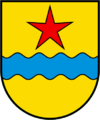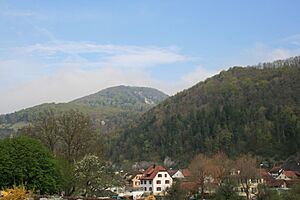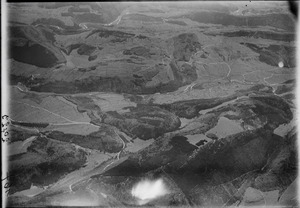Kleinlützel facts for kids
Quick facts for kids
Kleinlützel
|
||
|---|---|---|

Kleinlützel village
|
||
|
||
| Country | Switzerland | |
| Canton | Solothurn | |
| District | Thierstein | |
| Area | ||
| • Total | 16.32 km2 (6.30 sq mi) | |
| Elevation | 420 m (1,380 ft) | |
| Population
(Dec 2020 )
|
||
| • Total | 1,218 | |
| • Density | 74.63/km2 (193.30/sq mi) | |
| Postal code |
4245
|
|
| Localities | Huggerwald, Ring | |
| Surrounded by | Burg im Leimental (BL), Kiffis (FR-68), Liesberg (BL), Roggenburg (BL), Röschenz (BL), Wolschwiller (FR-68) | |
Kleinlützel (also called Petit-Lucelle in French) is a small town, or municipality, in Switzerland. It's part of the Canton of Solothurn. Kleinlützel is special because it's an exclave. This means it's a piece of land that belongs to Solothurn but is surrounded by other areas. It's like an island of Solothurn land, surrounded by the Canton of Basel-Country and a region in France called Alsace.
Contents
History of Kleinlützel
Kleinlützel has a long history. It was first mentioned in official papers way back in 1194. Back then, it was called Luozela.
Later, in 1207, it was known as de Minori Luzela. By 1288, people started calling it Kleinen Lützel.
Geography of Kleinlützel
Kleinlützel covers an area of about 16.29 square kilometers (about 6.3 square miles). A big part of this area is covered by forests. About 59.3% of Kleinlützel is forest, which is great for nature lovers!
About 36% of the land is used for farming. This includes fields for crops and pastures where animals graze. A small part, about 4.5%, has buildings and roads.
The town is located in the Thierstein district. Remember, it's an exclave, meaning it's separated from the main part of its canton. It sits along the Lützeltalstrasse road.
Kleinlützel includes the main village and smaller areas called hamlets. These hamlets are Ober- and Nieder-Huggerwald and Ring. There's also a former nun's convent called Klösterli.
Kleinlützel's Coat of Arms
Every town has a special symbol called a coat of arms. It's like a town's unique badge. Kleinlützel's coat of arms looks like this:
It has a golden background. Across the middle, there's a wavy blue stripe. Above this stripe, there's a red five-pointed star.
People and Population
Kleinlützel has a population of about 1,200 people. Most people in Kleinlützel speak German. About 92.8% of the residents speak German. Some people also speak Italian or French.
In 2008, about 6.7% of the people living in Kleinlützel were from other countries. The population has stayed pretty stable over the years.
Age Groups in Kleinlützel
Looking at the age of people in Kleinlützel in 2000:
- About 8.4% of the population were young children (0-6 years old).
- Teenagers (7-19 years old) made up about 15% of the population.
- Adults between 25 and 44 years old were the largest group, making up about 27.3%.
- People aged 65 and older made up about 18.1% of the population.
Homes and Households
In 2000, there were 516 private homes in Kleinlützel. On average, about 2.4 people lived in each home.
- About 26.7% of homes had only one person living in them.
- Some homes had five or more people.
- Many homes were lived in by married couples, with or without children.
Most of the buildings in Kleinlützel are single-family homes. About 69% of all inhabited buildings are single-family homes. Many of these homes were built a long time ago, before 1919, but new ones are also being built.
Population Changes Over Time
The chart below shows how Kleinlützel's population has changed through history:

Economy of Kleinlützel
Kleinlützel has different types of jobs and businesses. In 2010, the unemployment rate was low, at 2.8%.
Job Sectors
- Primary Sector: This includes jobs related to nature, like farming. In 2008, about 56 people worked in this sector, mostly in agriculture.
- Secondary Sector: This involves making things, like in factories or construction. About 229 people worked here, with most in manufacturing.
- Tertiary Sector: This is the service sector, like shops, restaurants, and schools. About 66 people worked in this sector.
Many people who live in Kleinlützel travel to other towns for work. In 2000, about 377 people commuted away from Kleinlützel for their jobs. About 23.9% of workers used public transportation, and 46.9% used a private car.
Religion in Kleinlützel
In 2000, most people in Kleinlützel were Roman Catholic, making up about 73.5% of the population. About 12.7% belonged to the Swiss Reformed Church.
A small number of people belonged to other Christian churches, Islam, Buddhism, or Hinduism. About 10.38% of the population did not belong to any church.
Education in Kleinlützel
Education is important in Kleinlützel. About 40.5% of the population has finished high school (upper secondary education). About 6.2% have gone on to higher education, like university.
School System
The school system in the Canton of Solothurn works like this:
- Kindergarten: Young children can attend two years of kindergarten, which is not mandatory. In 2010-2011, there were 24 children in kindergarten.
- Primary School: Students must attend six years of primary school. In Kleinlützel, there were 113 students in primary school during that same school year.
- Secondary School: After primary school, students go to lower secondary school for three mandatory years. After that, they can choose to go to advanced schools for three to five more years. Students from Kleinlützel attend secondary school in a nearby town.
In 2000, 74 students from Kleinlützel went to schools outside the municipality.
See also
 In Spanish: Kleinlützel para niños
In Spanish: Kleinlützel para niños







